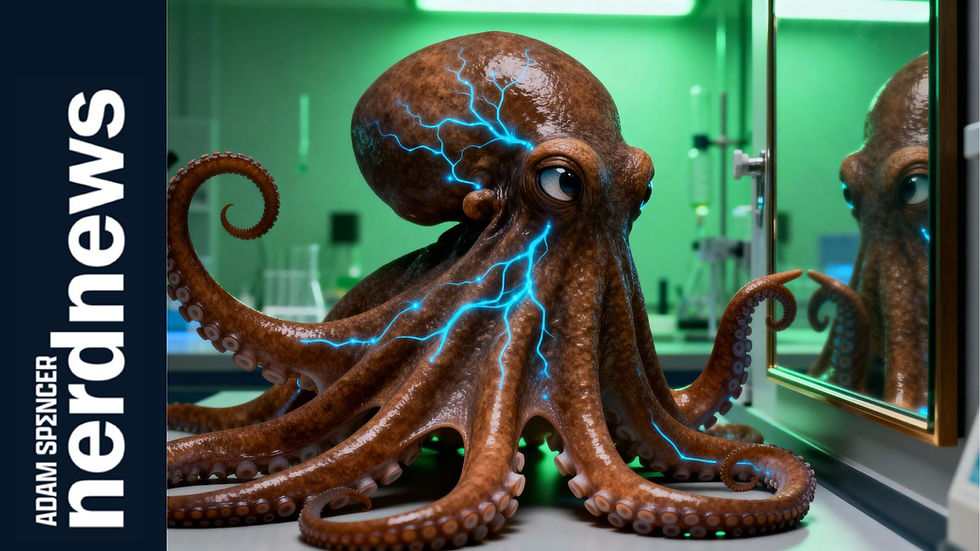Building life in the lab: Jacob Hanna and the synthetic embryo revolution
- Adam Spencer

- Nov 26
- 3 min read
Jacob Hanna’s team grows embryo-like structures from stem cells, questioning the origins of life and starting an ethical storm.
Life outside the body? Welcome to the new frontier
Imagine the beginnings of a human body.
Not inside a womb, in a spinning glass jar.
That’s the reality in Jacob Hanna’s lab at Israel’s Weizmann Institute, where his team is building synthetic embryos using stem cells.
Hanna’s group has coaxed stem cells into embryo-like structures that pulsed, divided, and self-organised. All outside nature’s cradle.
NerdNews examines science fiction turned fact and the beginnings of a deep debate.
You go for it stemmy.
Unlike most starry-eyed nine-year-olds, stem cells really could be anything when they grow up.
Most cells in your body are locked into their roles. Skin stays skin, neurons stay neurons.
But stem cells can become almost anything: gut lining, heart muscle, even the first flickers of brain tissue.
In the lab, you can shepherd them into tissues, organs, even embryo-like formations.
You were once a bunch of stem cells.
In the earliest days after conception, almost every cell in the embryo is a stem cell.
As development unfolds, those cells gradually specialise — some forming skin, some organs, some blood — and the number of true stem cells drops sharply.
By adulthood, they’re rare, hiding mostly in bone marrow, skin, and the gut lining, quietly repairing damage.
Even more astonishingly, scientists have learned how to take these older, less flexible adult cells and rewind them into a younger, more powerful state. In doing so, turning back a cell’s biological clock.
Hanna’s team take stem cells with the potential to become almost anything (‘naive pluripotent stem cells’ if you’re looking to nerd-flex) and give them just a few basic cues.
Amazingly, these cells then build the early structure of life all by themselves.
A fascinating (and slightly unsettling) example of nature doing its thing in a dish.
“These embryo models recapitulate natural embryogenesis very well… the main differences may be consequences of the placenta forming improperly.” Prof Magdalena Zernicka-Goetz, Caltech
Quick question; what is life anyway?
So without involving sperm, eggs or wombs, instead by spinning stem cells in a chamber,
Hanna’s team created synthetic embryo-models with beating hearts, flickers of brain tissue, and even placenta-like layers.
These aren’t destined for birth, but they develop very like natural embryos — at least until the artificial environment fails.
The models sidestep the womb but challenge our very idea of what counts as a “beginning.”
Big promise, bigger questions
The implications are enormous. These models promise new therapies, better organ printing, and an unprecedented look into infertility and miscarriage.
But the ethical terrain is evolving fast. Are these synthetic embryos just sophisticated cell cultures — or something closer to life itself?
“The big question is how the boundary between a tissue culture and a human organism is going to be drawn and on what criteria.” J. Benjamin Hurlbut, bioethicist
Many regulators still treat them as research tools, not potential persons. Yet the line is blurring, and ethicists warn the law is lagging behind the lab.
“I would have no argument against considering synthetic human embryos ethically as equivalent to natural ones.” Lluís Montoliu, Spanish National Research Council
Lighting up the frontier
Hanna and his colleagues have opened a window into the dawn of life. The potential is dazzling: bespoke organ factories, better disease models, and maybe even spare parts for bodies. But it’s also deeply unsettling.
Sure, we’re not “building babies” yet. But you’d have to agree we just got a step closer, yeah?
For now, the next chapter is being written in a lab — reminding us that the adventure of life isn’t over.
It’s just taking its first steps … outside the body.
-Adam S





Comments